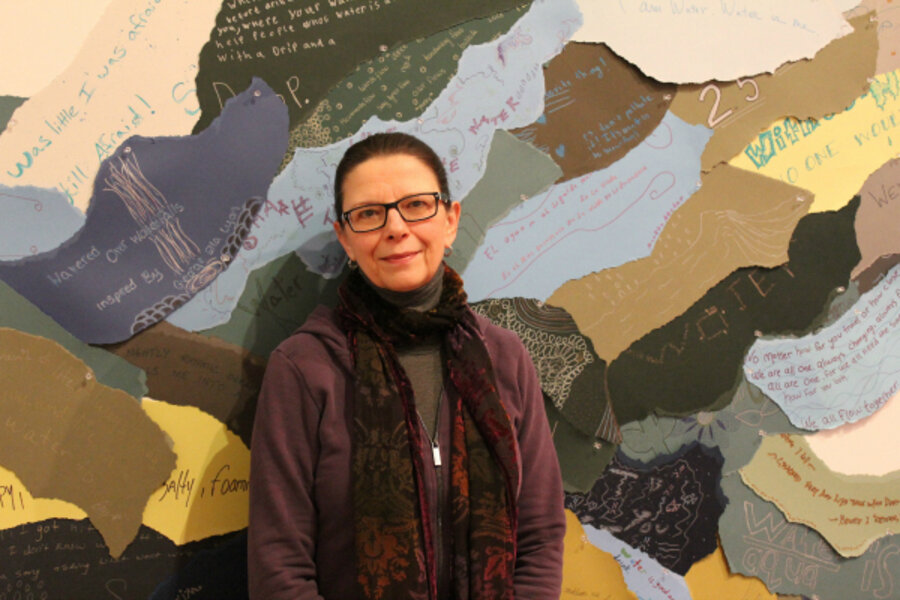Art for Water helps people go deep in their thinking about water
Loading...
Water is at once something so close at hand and yet so vast, so powerful and yet so fragile.
Fully understanding the importance of water can be difficult. But as global supply of clean water declines and a global water crisis approaches, thinking about how to use water efficiently become increasingly important.
Less than 1 percent of the world’s water is used by humans, but much of this water is wasted. It is estimated that the average American uses between 100 and 175 gallons of water each day, while someone in a developing country uses about 2.5 gallons a day.
According to United Nations’ Water Facts and Figures, close to 1 billion people in the world do not have access to clean water. Experts predict that by 2025, global demand for clean water will exceed supply by 56 percent.
In the face of these water facts, Christine Destrempes, an artist in Harrisville, N.H., has made it her mission to make people think more about water.
Ms. Destrempes is the head of Art for Water, a program begun in 2007 and sponsored by the nonprofit arts service organization Fractured Atlas. In addition to listing the above facts about water on its website, Art for Water produces participatory art projects that have been brought to communities throughout the United States, a country where water’s abundance can easily be taken for granted.
“Most people don’t think about water,” Destrempes says. “The purpose is to just get people to start thinking about it and realize their personal connection.”
Finding her own connection to water through art is something Destrempes had to do first. It started in 1995 when Destrempes gave up her graphic design business to devote more time to creating fine art. She soon decided to focus her painting and printmaking on subjects related to the environment, an issue she was both passionate about and challenged by.
In 2002, Destrempes narrowed her artistic focus more when she came across a New Yorker magazine article by William Finnegan called “Leasing the Rain.” The article described the clean water crisis in Bolivia and how corporate water privatization was becoming a reality there.
“That’s where I learned that 5 million [people] die every year from preventable water[-related] diseases,” Destrempes says. She was also unnerved by the idea of water privatization, of corporate entities taking control of humanity’s most basic resource just as it becomes scarce. “That really gave me the creeps,” she says.
Destrempes ultimately decided to make art about water.
“I wanted to raise awareness about water from an aesthetic standpoint,” she says. But after being chosen by a Massachusetts art competition to give a gallery talk about one of her monotypes, Destrempes says she felt uncomfortable about her art and her message.
“For me, there was this really big disconnect.” she recalls. Then she watched artist Nathalia Miebach give her own gallery talk in which she demonstrated her method of using storm data to create sculptures. “I realized that her message was her medium,” Destrempes says.
Inspired, in 2007 Destrempes began what would become the first Art for Water project, "13,699." It involved stringing 13,699 clear bottle caps together over the course of a year and a half: The caps represented the number of deaths each day caused by preventable water-related diseases.
She asked people of all ages to help her with the project: preschool children, grade-school classrooms, college students, and people in adult day care centers. “Hundreds of people helped me string the bottle caps,” Destrempes says.
The project eventually went on display for the first time in 2009 at the Sharon Arts Exhibition Gallery in Peterborough, N.H., and it has been shown in galleries across the US since then.
Destrempes also began a second Art for Water project, "Stream of Conscience," a collection of answers to the question "What do words have in common with water?" The resulting art projects, made out colored scraps of paper put together like a flowing stream, have been displayed across the country, beginning with a Peterborough, N.H., gallery in 2011.
She now is trying to make the project virtual, so that people around the world can participate. “The installation is more interesting,” she says, the larger the mix of participants.
Through these projects, Destrempes hopes she will inspire creativity, awareness, dialogue, and change. Participants have told her that they are making efforts to run their dishwashers or washing machines only with a full load or that they have stopped buying bottled water, which uses an additional gallon of water to produce each bottle.
“These projects are planting seeds in people’s minds that this is something they should pay attention to,” she says. “[A clean water supply] is going to become a really huge issue.”
For Destrempes, the most important accomplishment of Art for Water is having people realize how connected they are through water.
“I think water is alive,” she says. “Water is a metaphor for life: We’re all connected.”
• To learn more about Art for Water, visit www.artforwater.org.







